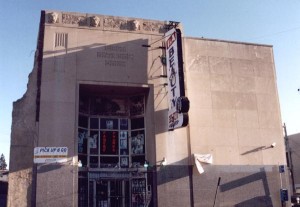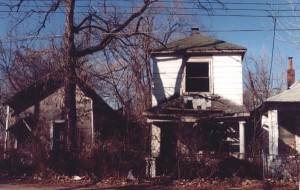White Flight and Urban Renewal: Wellston’s Decline

A storefront in the Wellston shopping district along Martin Luther King Boulevard (formerly Easton Avenue), January 2003 (permission requested, Robert Powers)
In the 1950s and ‘60s, Wellston hit a period of decline from which it has not yet recovered.
Mayor Leo J. Hayes, according to a 1967 St. Louis Post-Dispatch article, “looked on urban renewal as a major step toward solving the city’s problems, which have been compounded by a shrinking tax base, an exodus of middle class property owners and an influx of poor people drawn to the community by low cost housing, much of it substandard.”
A 1971 study of Wellston provided this picture of the city:
A vast majority of the housing in Wellston was built around 1900, and few improvements have been made; and since the City cannot expand beyond its present boundaries, we witness a sad picture of blight and decay. There are many vacant homes which at their time of occupancy could not pass the housing code and are presently beyond the point of being rehabitable. Land clearance has been at a low point of deficiency. Fires have partially destroyed some of the derelict homes, and large vermin and rats have constantly pilgrimaged to Wellston to habitat homes fit only for them.
“As the housing market fell apart,” notes the City of St. Louis website, “lower-income residents moved into the neighborhood and homes lay vacant. In the 1980’s, problems of abandoned buildings, crime, drugs and teenage pregnancy arose.”

Housing on Wellston Avenue, December 2002 (permission requested, Robert Powers; Powers notes that nonexistent housing and property codes result in houses that are “made of lighter, cheaper materials,” a lack of curbs or sidewalks, and “a proliferation of trees that almost seem to be running wild”)
Robert Powers’s essay, “The North Side: The Decline of the City,” offers an excellent summary of thefactors that led to the neighborhood’s demise. You can see the urban prairie that encompasses much of Wellston on Powers’s tour of MLK West.
Next.